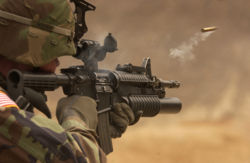Army: Difference between revisions
imported>Howard C. Berkowitz (Being consistent about calibers, and mutters about the U.S. tendency to keep repeating designations. Isn't an M4 a Sherman tank? :-<) |
imported>Howard C. Berkowitz (Clarified operational vs. tactical levels, national usage) |
||
| Line 1: | Line 1: | ||
{{subpages}} | {{subpages}} | ||
[[Image:Casing.jpg|thumb|250px| A U.S. Army soldier firing a 5.56 mm round from an M4 rifle (the M4 also has an M203 40mm Grenade Launcher attached).]]An '''Army''' is a term either referring to the largest | [[Image:Casing.jpg|thumb|250px| A U.S. Army soldier firing a 5.56 mm round from an M4 rifle (the M4 also has an M203 40mm Grenade Launcher attached).]]An '''Army''' is a term either referring to one of the largest types of [[formation]] for a land-based military force, or the entirety of a nation's military force responsible for its land defenses, both of which are composed of [[Soldier|soldiers]], trained to engage in [[war]]. | ||
An army, as a single in-theater force, operates at a [[Strategy|strategic]] level, but is composed of | An army, as a single in-theater force, operates at a [[Strategy|strategic]] level, but is composed of smaller operational units which operate at at the level of [[military doctrine#Operational art|operational art]] or [[military doctrine#tactics|tactics]]. | ||
In modern warfare, a '''field army''' is an [[echelon above corps]], but usually more an administrative than operational headquarters. It is unlikely that multiple field armies will ever be in battle, but, in the Second World War, '''army groups''' were operational headquarters for multiple field armies. | |||
Not all countries use "army" to indicate the same level of command. Western practice is that a field army is made up of two or more [[corps]], and is commanded by a full general or lieutenant general. WWII Japanese "armies" were of several levels; an unqualified "army" was equivalent to a Western corps, an "area army" to a field army, and a "general army" to an army group. | |||
Revision as of 19:17, 23 May 2008
An Army is a term either referring to one of the largest types of formation for a land-based military force, or the entirety of a nation's military force responsible for its land defenses, both of which are composed of soldiers, trained to engage in war.
An army, as a single in-theater force, operates at a strategic level, but is composed of smaller operational units which operate at at the level of operational art or tactics.
In modern warfare, a field army is an echelon above corps, but usually more an administrative than operational headquarters. It is unlikely that multiple field armies will ever be in battle, but, in the Second World War, army groups were operational headquarters for multiple field armies.
Not all countries use "army" to indicate the same level of command. Western practice is that a field army is made up of two or more corps, and is commanded by a full general or lieutenant general. WWII Japanese "armies" were of several levels; an unqualified "army" was equivalent to a Western corps, an "area army" to a field army, and a "general army" to an army group.
